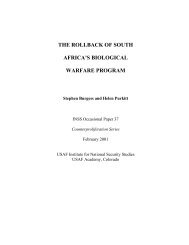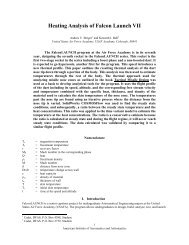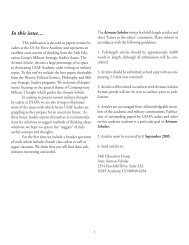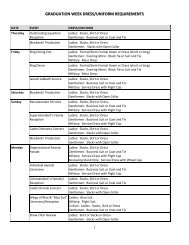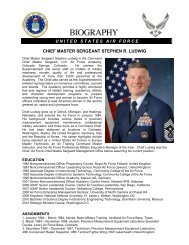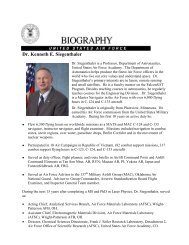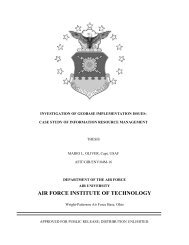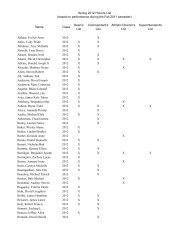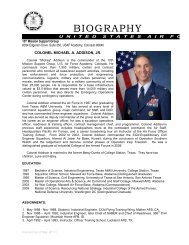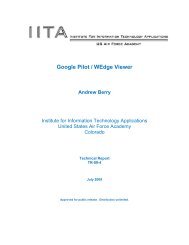Air Force Digital Technical Orders - United States Air Force Academy
Air Force Digital Technical Orders - United States Air Force Academy
Air Force Digital Technical Orders - United States Air Force Academy
Create successful ePaper yourself
Turn your PDF publications into a flip-book with our unique Google optimized e-Paper software.
<strong>Air</strong> <strong>Force</strong> <strong>Digital</strong> <strong>Technical</strong> <strong>Orders</strong>:<br />
Technologies and Applications for the Future<br />
Lt Col Ellen M. Fiebig, USAF<br />
Captain Anthony S. Martinez, USAFR<br />
IITA Research Publication 3<br />
Information Series<br />
December 2002<br />
Approved for public release. Distribution unlimited.
ABOUT THE AUTHORS<br />
Lieutenant Colonel Ellen Fiebig is the Director, Reserve Research at the<br />
Institute for Information Technology Applications (IITA), <strong>United</strong> <strong>States</strong> <strong>Air</strong> <strong>Force</strong><br />
<strong>Academy</strong>. She is a 1984 graduate of the <strong>Academy</strong> and is a Communications-<br />
Computer Systems Officer. She has 8 years of active duty where she served as<br />
an OIC, Maintenance Control, Chief of Maintenance and Systems Flight<br />
Commander. She served for 7 years in the <strong>Air</strong> <strong>Force</strong> Reserve as a Wing<br />
Executive Officer and Mission Support Squadron Commander. She has<br />
participated on 6 deployments, both real-world contingencies and training<br />
deployments. She returned to active duty status Feb 2000 in her current<br />
position.<br />
Captain Anthony Martinez is a 1993 Graduate of the U.S. <strong>Air</strong> <strong>Force</strong><br />
<strong>Academy</strong>. In addition to his primary assignment in military logistics as an <strong>Air</strong>craft<br />
Maintenance Officer, Capt Martinez has conducted academic and technology<br />
research as a college <strong>Air</strong> <strong>Force</strong> ROTC Professor, and Engineering Manager with<br />
Qwest Communications International. He is currently an adjunct faculty member<br />
at Parks College in Denver, Colorado, where he is responsible for developing<br />
business applications and technology training tools. Capt Martinez holds a<br />
Bachelor of Science Degree in Economics from the <strong>Academy</strong>, as well as a<br />
Master’s Degree in Aerospace Science and <strong>Technical</strong> Management from Embry<br />
Riddle Aeronautical University. He is currently assigned to the 9001 st <strong>Air</strong><br />
Recruiting Squadron, headquartered at the <strong>Air</strong> Reserve Personnel Center<br />
(ARPC) in Denver, Colorado.<br />
The views expressed in this paper are those of the authors and do not necessarily reflect the<br />
official policy or position of the Institute of Information Technology Applications, the Department of<br />
the <strong>Air</strong> <strong>Force</strong>, the Department of Defense, or the US Government.<br />
________________________________________<br />
Comments pertaining to this report are invited and should be directed to:<br />
Sharon Richardson, Director of Conferences and Publications<br />
Institute for Information Technology Applications<br />
HQ USAFA/DFPS<br />
2354 Fairchild Drive, Suite 6L122<br />
USAF <strong>Academy</strong> CO 80840-6258<br />
Tel. (719) 333-2746; Fax (719) 333-2945<br />
e-mail: sharon.richardson@usafa.af.mil<br />
ii
TABLE OF CONTENTS<br />
Acknowledgments v<br />
Abstract vi<br />
Introduction 1<br />
Background 2<br />
I. Methods 2<br />
II. Conducting the Research 4<br />
III. Survey Results 5<br />
IV. Discussion 8<br />
V. Conclusions and Recommendations 12<br />
Appendices<br />
Appendix A SecDef Memo, 2 July 1997 14<br />
Appendix B goReader Report 15<br />
Appendix C Survey 20<br />
Appendix D Equipment Description 24<br />
Glossary 26<br />
Glossary of <strong>Technical</strong> <strong>Orders</strong> 27<br />
Reference Notes 27<br />
iii
LIST OF FIGURES<br />
Figure 1 Comparison of Paper vs <strong>Digital</strong> <strong>Technical</strong> Order 1<br />
Figure 2 goReader Device 2<br />
Figure 3 Technicians using the CF-34 and MDWD-07 3<br />
Figures 4-9 Survey Responses 5-8<br />
Figure 10 Technician using MDWD-07 9<br />
Figure 11 Screen Comparisons 9<br />
Figure 12 CF-34 and Paper TO 12<br />
LIST OF TABLES<br />
Table 1 Site-Surveyed Bases 4<br />
Table 2 IETM Software Translations/Definitions 5<br />
iv
Acknowledgements<br />
The authors would like to thank the following people for their assistance in make this<br />
research possible. First and foremost, we would like to thank <strong>Air</strong> <strong>Force</strong> Reserve<br />
Command, specifically, Lt Col Ray Cancilleri for his outstanding support and assistance.<br />
He was truly the catalyst behind this study. Many thanks also to Brigadier General<br />
Ryder, AFRC/LG for his support in financing the hardware and allowing us to brief our<br />
results at the LG steering conference.<br />
In addition, we would like to thank Panasonic, specifically Mr. Michael Krouse for his<br />
assistance and for allowing testing of various systems.<br />
We would also like to thank all the participants at the 4 Reserve and 2 <strong>Air</strong> National<br />
Guard F-16 Wings: 944 th FW, 301 st FW, 419 th FW, 482 nd FW, 140 th FW, and the 169 th<br />
FG, for their patience in using the IETMS and for taking part in the survey.<br />
v
ABSTRACT<br />
This twelve-month research study was a small part of a larger <strong>Air</strong> <strong>Force</strong> study to fulfill<br />
Department of Defense directives to transition to a digital environment for acquisition<br />
programs by the end of 2002. 1 (Appendix A) The research study, which involved over<br />
200 active and reserve jet engine aircraft maintenance troops at installations nationwide,<br />
was designed to support the <strong>Air</strong> <strong>Force</strong> strategy of “Global Technology Deployment” by<br />
providing and testing jet engine maintenance technical order manuals in digital form, and<br />
integrating the correct technology to utilize the digital application. In addition, it speaks<br />
to the cultural issues associated with incorporating a dramatic technological change.<br />
Participants were sent the latest version of the F-16 interactive electronic technical<br />
manual (IETM) software to use for a few months prior to testing ”ruggedized” hardware.<br />
They were also sent a research survey, which measured the utility of the combination of<br />
software and ruggedized hardware. Finally, depot/vendor sponsored training on the<br />
software and hardware was provided at various installations. The study demonstrated<br />
the feasibility, using “ruggedized” hardware and advanced software combinations and<br />
the potential of expanding the use of other technologies into other areas of military<br />
logistics. Initial recruitment of participants was facilitated by the <strong>Air</strong> <strong>Force</strong>-wide<br />
deployment of IETM software to all F-16 Jet Engine Propulsion Maintenance Shops.<br />
The research survey and interviews proved to be useful for data collection, which<br />
allowed jet engine maintenance troops to express views and opinions on issues relevant<br />
to the overall <strong>Air</strong> <strong>Force</strong> Project. Of those participants that completed the survey, 90%<br />
indicated they agreed or strongly agreed that this was an effective method of<br />
maintenance. The research concludes with recommendations for developing and<br />
conducting future logistics technology research for the military.<br />
vi
INTRODUCTION<br />
AIR FORCE DIGITAL TECHNICAL ORDERS:<br />
TECHNOLOGIES AND APPLICATIONS FOR THE FUTURE<br />
The <strong>Air</strong> <strong>Force</strong> <strong>Technical</strong> Order (TO) System provides educational and<br />
operational tools for supporting AF-wide operations and maintenance programs. The<br />
system acquires, maintains, stores, distributes, and manages technical information,<br />
instructions, and safety procedures pertaining to AF equipment. If TOs are not kept<br />
accurate and current, downtime for maintenance increases and operational readiness<br />
decreases. Untimely or inadequate technical information increases the possibility for<br />
damage or destruction of equipment and creates potentially unsafe operational and<br />
maintenance environments. 2<br />
The current TO system is primarily paper-based and was designed in the 1940s.<br />
Digitization of these documents began in FY97 with the B-1. Digitization extended to<br />
some munitions and weapons systems (AIM7-9, AGM-88, AGM-65, Aerial Targets, War<br />
Reserve Material (WRM) Ammunition, AEWS, GTACS, and Range Threats) in FY01. At<br />
present, digitization has been completed for the C-17, C-5, C-141, KC-10, C-130J, C-9,<br />
C-20B, CV-25. 3 In January, 2002, the first F-16 propulsion systems were fully digitized<br />
which allowed for improved interactivity through IETM’s. The software was fielded to<br />
active and reserve <strong>Air</strong> <strong>Force</strong> installations to improve the efficiency and reliability of field<br />
maintenance on the aircraft. Current <strong>Air</strong> <strong>Force</strong> Logistics Plans are for IETM’s to be<br />
utilized for all next generation aircraft and weapons systems which are currently under<br />
development.<br />
Moving to a completely digital environment would be advantageous for several<br />
reasons. First, a digital environment would allow the most accurate and up-to-date TOs<br />
distributed electronically in the least amount of time. Secondly, there would be<br />
considerable man-hour savings in posting changes and errors would be virtually<br />
eliminated. Wear and tear on paper products would also be eliminated.<br />
In addition, there would be a<br />
signification reduction of the<br />
“mobility footprint”, when CDs<br />
or web-based access could<br />
replace paper during<br />
deployments. There are 1.4<br />
million pages of technical data<br />
to support the F-16 fleet<br />
worldwide—about 14,000<br />
pounds of paper. 4 One e-tool<br />
device, tested in this research,<br />
weighs about eight pounds and<br />
can hold the entire F-16<br />
technical data set, saving<br />
valuable pallet space.<br />
Figure 1 Comparison of Paper vs <strong>Digital</strong> <strong>Technical</strong> Order
BACKGROUND<br />
At the request of <strong>Air</strong> <strong>Force</strong> Reserve Command (AFRC)/LGA,<br />
Robins AFB, Georgia, the Institute for Information Technology<br />
Applications (IITA) was asked to perform initial testing of e-tools,<br />
using a particular “e-reader” device. The goReader (Figure 2)<br />
was selected to be tested simultaneously with an IITA classroom<br />
educational technology project. This device was tested at three<br />
F-16 bases, Buckley <strong>Air</strong> National Guard (ANG), Shaw AFB and<br />
McEntire ANG with disappointing results. Some of the major<br />
shortfalls were lack of memory and poor battery life. Most<br />
significant, however, was the lack of durability. When moving<br />
the reader device around, data would frequently surge or be<br />
completely lost. (See Appendix B, IITA Progress Report)<br />
Subsequently, IITA recommended follow-on research to be<br />
conducted on “ruggedized” electronic technology for digital TO use. AFRC purchased<br />
the Panasonic CF-28 Toughbooks for testing at 4 AFR F-16 Bases: The 944 th Fighter<br />
Wing, Luke AFB, AZ; the 301 st FW, Carswell JRB; the 419 th FW, Hill AFB, Utah; and the<br />
482 nd Figure 2 goReader Device<br />
Figure 2 goReader Device<br />
FW, Homestead AFB, Florida. In addition, IITA purchased a Panasonic MDWD-<br />
07, “wearable” computer and Panasonic contributed one CF-34 Toughbook for additional<br />
testing.<br />
I. METHODS<br />
Experimental Design. The objectives of this research were to examine the software and<br />
hardware associated with the <strong>Air</strong> <strong>Force</strong> digital <strong>Technical</strong> Order Program by providing the<br />
necessary IETMS software and hardware, facilitate training, and evaluate data use in the<br />
field. Subsequently, the methods used in this research included: Site Survey, Written<br />
Field Survey, and actual deployment evaluation of the digital <strong>Technical</strong> Order software<br />
and hardware.<br />
Agencies and Participants. The research required selection of a sample populace of Jet<br />
Engine Maintenance troops to participate in testing the devices. Participants were<br />
selected with input from <strong>Air</strong> <strong>Force</strong> Reserve Command (AFRC), <strong>Air</strong> <strong>Force</strong> Materiel<br />
Command (AFMC), and the IETMS’ project leads from the <strong>Air</strong> <strong>Force</strong> Depot Level<br />
Maintenance Program. Participants were both military and civilian, from both active and<br />
reserve forces and included all ranks within the logistics field.<br />
The primary companies responsible for the development and programming of the IETM<br />
software included <strong>Air</strong> <strong>Force</strong> General Contractors Lockheed Martin and General Electric.<br />
Procedures. In November 2001, the CF-28s were fielded to the 4 F-16 Reserve Bases.<br />
In January 2002, the bases received the latest F-16 engine IETMS.<br />
Site Survey<br />
From January 2002 to May 2002 a series of site surveys were conducted to assist in<br />
implementing the new technology and administer surveys to gather data to determine<br />
the effectiveness of this technology. The principal criterion evaluated in the site survey<br />
included:<br />
2
• The size of the display<br />
• Ruggedization characteristics of the device<br />
• Ease in locating the power button on the device<br />
• The layout of the keyboard<br />
• Ease in using the pointing device<br />
• Navigating through the program<br />
• Ease in entering data into the device<br />
• The use of drop down menus<br />
• Ease in reading data while the device was in direct sunlight<br />
• The perceived portability of the device<br />
• Ease in entering data while wearing chemical resistant gear<br />
• Adaptation of the technicians to the new technology<br />
Written Field Survey<br />
A copy of the actual research survey used in the field is attached as Appendix B. The<br />
paper survey was designed to access whether or not the digital IETMS were actually<br />
utilized, determine the computer skill levels of the technicians and test the adequacy of<br />
the hardware used, primarily the Panasonic CF-28 Laptop. Data was obtained regarding<br />
the durability and ergonomic issues associated with the use of the laptop computer. In<br />
addition, assessments were made on the “comfort level” of the technicians with this<br />
technology.<br />
Deployment Evaluation<br />
Figure 3 Technicians using the CF-34 and MDWD-07<br />
The actual deployment of the devices to off station locations was tested by both active<br />
and reserve bases. Deployment with IETMs digital <strong>Technical</strong> <strong>Orders</strong> was first attempted<br />
by Shaw <strong>Air</strong> <strong>Force</strong> Base in January 2002 during a training mission. However, due to the<br />
continuous upgrades taking place with the software and hardware, printed backup<br />
technical data was necessary to accomplish much of the maintenance during the<br />
3
deployment to ensure continuity. In May 2002, the 482d Reserve wing, Homestead<br />
ARS, was able to successfully accomplish a small training deployment to Tyndall AFB<br />
without the need for paper TO assistance. The paper version was available for back-up.<br />
II. CONDUCTING THE RESEARCH<br />
Subject Demographics<br />
The research data collected was from maintenance troops assigned to each of the<br />
bases listed in Table 1 below. Participants were required to attend training seminars on<br />
the use of the IETMS software and hardware. The total number of subjects participating<br />
varied due to both unit TDY schedules and individuals voluntarily requesting to be added<br />
or removed after the research survey period had begun. The decision to add personnel<br />
was based on whether or not the subject had received the <strong>Air</strong> <strong>Force</strong> IETMs training.<br />
Wide varieties of expertise and years on the F-16 aircraft existed in the subject pool;<br />
therefore a typical profile could not be established. However, the following are<br />
significant facts on the participants which provide partial descriptions:<br />
1. The average amount of Reserve experience working on jet engines was 11<br />
years.<br />
2. The number of subjects reporting ability to respond to the survey was 218.<br />
3. Subjects were members of the active duty USAF, USAF Reserve, <strong>Air</strong> National<br />
Guard, and civilian <strong>Air</strong> Reserve Technicians.<br />
4. While only 5 bases were actually visited, subjects applicable to this study were<br />
assigned to more than 15 different installations. This larger sampling was<br />
possible because IITA extended research by including all attendees at jet<br />
propulsion IETMs training, whose attendance was made up of technicians from<br />
active and reserve installations nation-wide.<br />
5. Motivation to use the new technology varied, but was directly related to the level<br />
of computer skill expertise.<br />
Table 1: Site-Surveyed Bases<br />
Date Location Number of Participants<br />
Sep 01 Shaw AFB 55<br />
Feb 02 Hill AFB 83<br />
Mar 02 Carswell ARS 17<br />
May 02 Homestead ARB 51<br />
Jan 02 Luke AFB 12<br />
The IETM’s Software<br />
The software was developed by Lockheed and General Electric under contract with the<br />
<strong>Air</strong> <strong>Force</strong> Logistics Depot Maintenance Program. Each contractor has Defense<br />
agreements with the Department of the <strong>Air</strong> <strong>Force</strong> to develop the digital jet engine TO on<br />
the F-110 & 220 engines. Evaluation of the software took place prior to field deployment<br />
to determine the best possible hardware to be used with the program. The instructional<br />
design for each version of the digital TO consisted of a web-based menu on the left side<br />
4
of each screen with the actual data appearing on the right side of the screen. Both<br />
remain visible on every page of the lesson. Data is largely available on CD-ROM in<br />
addition with web-server based capability.<br />
Many recommendations were provided to the companies to improve previous versions.<br />
For example, the need for increased interactivity for maintenance user interface was<br />
demonstrated. The following table describes the components of the IETMS software.<br />
Table 2: IETM Software Translations/Definitions<br />
MENU Section Definition<br />
TCTO Time Compliance <strong>Technical</strong> Order<br />
Work Package WP- Portion of the TO that is being worked at a given time.<br />
Diagram Schematic technical drawings as used in printed paper TO’s.<br />
The software was installed and resided on each hardware device tested. Limited CPU<br />
capability on the earliest ruggedized laptop models slowed the system. This was of<br />
particular concern with the flightline maintenance crews who needed timely information.<br />
Subjects were provided “touch screen” capability and a stylus pen with each hardware<br />
device to immediately scroll or click to required TO data. Additionally, subjects required<br />
actual access to the unit <strong>Technical</strong> Order Distribution Office in order to assure the<br />
correct version of the CD-ROM was in use (over 15 different versions have already been<br />
produced).<br />
Five days prior to each site visit, subjects were identified by the unit propulsion<br />
superintendent. This was to ensure that each subject had at least limited knowledge of<br />
using the application and computers. Additionally, during the site visit a demonstration<br />
period was conducted, followed by question and answer session before the research<br />
period began. Subjects then received 4 or more weeks to use the new hardware and<br />
software combination. The Depot made use of the technology mandatory for each<br />
installation undergoing the test, which helped facilitate greater participation in the<br />
project. Finally, technicians were administered the survey.<br />
III. SURVEY RESULTS<br />
1. How often do you use the digital T.O. in<br />
your current work environment?<br />
Always<br />
21%<br />
Often<br />
28%<br />
5<br />
Never<br />
9% Sometimes<br />
12%<br />
About Half<br />
the Time<br />
30%<br />
Figure 4: Survey Responses
Survey respondents indicated that usage of the digital TO’s exceeded 20% at<br />
installations using IETM’s software and hardware. An additional 28% indicated that they<br />
use the system often, but not all the time. A majority of respondents indicated use of the<br />
technologies at least half the time. Because the sample for this research was primarily<br />
composed of those trained and not completely familiar with the digital IETM’s, field data<br />
may not accurately depict the actual usage of the technology for the entire force.<br />
2. How often do you use a desktop or laptop personal<br />
computer?<br />
Always<br />
40%<br />
NeverSometimes<br />
0% 3%<br />
6<br />
Often<br />
33%<br />
About Half the<br />
Time<br />
24%<br />
Figure 5: Survey Responses<br />
Technology usage was a key element of this research because <strong>Air</strong> <strong>Force</strong> wide IT usage<br />
is generally lower in the operations and maintenance areas. In the propulsion engine<br />
shop arena, a majority of respondents indicated using computers of any type well over<br />
half the time. Much of this is a result of <strong>Air</strong> <strong>Force</strong> computerized aircraft maintenance<br />
system (CAMS) records as well as mobility aircraft data systems such as “GO81” and<br />
the command, control, communications, and information processing system (C3IPS).<br />
These systems, implemented over the past 10 years, now expose engine technicians to<br />
computers on a more frequent basis.<br />
3. In using the IETM digital TOs on your unit’s<br />
assigned “Toughbook” computer, do you ever stumble<br />
with technology issues that require additional training?<br />
Always<br />
36%<br />
Never<br />
1%<br />
Sometimes<br />
2%<br />
Often<br />
35%<br />
Figure 6: Survey Responses<br />
About Half<br />
the Time<br />
26%<br />
A large number of survey respondents indicated that lack of training on usage of the<br />
IETM’s product was an inhibitor to daily production. Due to cost constraints, training on<br />
IETM’s was conducted for just 5% of installation troops. The training model calls for<br />
those fully trained to become subject matter experts (SME’s) who, in turn, train the<br />
remaining troops in the unit. Results indicate that as of the survey period, the training<br />
was still necessary.
4. How often do you find the need to crossreference<br />
the data from the CD-ROM digital TO<br />
with an actual printed version of the TO?<br />
Always<br />
30%<br />
O ften<br />
30%<br />
7<br />
Never<br />
8% Sometimes<br />
11%<br />
Figure 7: Survey Responses<br />
About Half<br />
the Time<br />
21%<br />
60% of the maintenance troops who responded to the survey returned to paper TOs<br />
primarily due to the lower confidence levels on the accuracy of the IETMS technical<br />
order. Reliability was questioned as a result of the numerous revisions to the software.<br />
During the research period 7 versions of TO’s and time compliance orders were made.<br />
This concern was forwarded by our research team to the Oklahoma City <strong>Air</strong> Logistics<br />
Center (OC-ALC) who is responsible for certifying and validating data on digital TO’s for<br />
the F-16, <strong>Air</strong> <strong>Force</strong> wide. The <strong>Air</strong> <strong>Force</strong> TO Distribution office continues its effort in this<br />
area.<br />
5. During the period you have been using digital TOs,<br />
have you had any Inform ation Technology Problem s with<br />
the “Toughbook” hardware?<br />
About Half<br />
the Time<br />
19%<br />
Always<br />
O ften<br />
16%<br />
8%<br />
Sometimes<br />
21%<br />
Never<br />
36%<br />
Figure 8: Survey Responses<br />
IT troubles reported by respondents were higher than expected. Specific concerns were<br />
battery-life longevity, screen visibility, size of text, software, and connectivity. While<br />
many of these issues were alleviated with the acquisition of the CF-28, not all were<br />
abated. There were still concerns regarding the overall reliability of the electronic tools<br />
when becoming a 100% digital operation. In follow-up interviews with the test-bed<br />
location at Shaw AFB, SC, those workstations that were fully digital and utilizing IETMs<br />
software experienced very little or no difficulty when transitioning to 100% digital IETMS<br />
use. Comfort and training levels of the subjects were found to be a greater concern than<br />
the reliability of the data and electronic hardware.
6. Have you had any applications problem s<br />
with the software or CD-ROM Data?<br />
Always<br />
23%<br />
Often<br />
29%<br />
8<br />
Never<br />
8%<br />
Figure 9: Survey Responses<br />
Sometimes<br />
15%<br />
About Half<br />
the Tim e<br />
25%<br />
Software applications problems did exist with IETMs and the Computer Automated<br />
Maintenance System (CAMS) platforms, especially when operating on the same<br />
hardware device. More than 50% indicated having some trouble with the IETMs<br />
applications of multiple web browsers, HTML Frames, and searching. For example,<br />
earlier hardware and software versions were slower while the processing speed on the<br />
CF-28 was much faster allowing for better use of web-based applications. Technicians<br />
who utilized both IETMs and CAMS on the same hardware device would like to see even<br />
greater speeds when opening graphic functions and searching for TO maintenance work<br />
packages. In addition, the IETMs application can present trouble by “locking-up” on<br />
slower PC’s and hardware devices.<br />
IV. DISCUSSION<br />
The data collected during this research points to the following major findings,<br />
categorized by Hardware, Software and Cultural issues.<br />
Hardware Technology Issues<br />
The primary hardware used was the Panasonic CF-28, but 3 other approved Panasonic<br />
systems, the CF-27, CF-34, and MDWD-07 were fielded to test hardware possibilities<br />
based on size, memory, portability, durability, and usefulness with the IETMs application.<br />
Hardware is listed in Appendix D. Scalability and durability were the key hardware<br />
technology issues tested. The goal was to reduce the size of computer needed to<br />
perform IETMs work, but still be adequate to display the TO. The hardware tested met<br />
scalability requirements.
Ruggedized durability features, which differentiate<br />
the product line from the typical PC or laptop device<br />
available to most consumers, were essential for<br />
flightline operations. Each hardware device tested<br />
was engineered for industrial use, and designed using<br />
Military MIL-STD-810E test procedures used by the<br />
Department of Defense. Features of the hardware<br />
included hardened polymer cases which could<br />
accommodate excessive weight pressure and prevent<br />
damage. A typical drop-test of the hardware involved<br />
Figure 10 Technician using MDWD-07<br />
an 8ft drop onto hardened concrete. Each device tested<br />
easily passed this test. In addition, the hardware was water, chemical, and moisture<br />
resistant. This characteristic was very important as Jet Engine Maintenance facilities are<br />
surrounded by fuels, oils, and grease. The typical device tested by technicians would<br />
get dirty and greasy within just a few days use. Webbed rubber lining for keyboards as<br />
well as gasket gated portals for the hardware helped maintain hardware integrity.<br />
The screens on the hardware were upgraded during<br />
this research to include touch screen capability and<br />
scratch resistant enhancements. This was important<br />
as technicians preferred to use their hands or even<br />
work tools as opposed to a computer stylus when<br />
scrolling through work documentation. These upgrades,<br />
coupled with on screen capability and visibility were<br />
helpful in allowing design engineers to accommodate<br />
military needs in advancing tools from the CF-27 to the<br />
CF-28 device. The most recent modification included<br />
reducing the screen power usage requirements to facilitate<br />
longer battery life for the associated hardware.<br />
Software Issues<br />
Software issues drastically improved throughout the research study as newer versions<br />
hit the field.<br />
The early versions of digital TO’s were not web-based. A text only version with PDF files<br />
were used which did not allow for viewing diagrams and graphs that are essential to<br />
engine maintenance work.<br />
Software development involved moving all engine technical data to an interactive<br />
electronic format. Teams from AFMC and civilian software developers met to discuss<br />
the application, and in the end a web-based interface was selected as the most viable<br />
method due to troop familiarity with application such as Microsoft Internet Explorer.<br />
Versions 1.0 and 2.0 of the IETM’s software presented difficulty with data accuracy,<br />
processing speeds, and program execution due to the use of ‘transposed’ TO data which<br />
was converted form actual printed text and programmed in xTML and HTML web-based<br />
languages. This resulted in several delays, first in working out programming errors, and<br />
later in making the electronic data as accurate as the printed TO version. This process<br />
required data to be screened by <strong>Air</strong> <strong>Force</strong> TO managers.<br />
9<br />
Figure 11. Screen Comparisons
At the same time, diagrams and other graphics were not drawn to scale when used in<br />
the web-based mode. As a result, the team decided to create an enhanced graphics<br />
interface which would allow for scalability of all images allowing them to be blown up<br />
beyond that of the traditional paper TO. As a result, one of the finer aspects of the<br />
IETMs software as discussed by troops was the ability to use enhanced images and<br />
graphics.<br />
Later versions of the software addressed many shortcomings reported from the field.<br />
Today’s IETM’s allows for both network and non-network connectivity for data, and<br />
permits multiple windows to be opened at the same time allowing for troops to access<br />
both the TO, Indices, and other electronic maintenance applications on the same<br />
computer.<br />
Cultural Issues<br />
Preliminary assessment of troop “comfort” with the technology found some initial<br />
hesitation with implementation. In some cases, the site survey found researchers<br />
actually having to remove the equipment from original packing. After familiarization, the<br />
IETMS software, specifically the web-based format was found to be user-friendly and the<br />
subjects appreciated having everything they needed to do their work, but there were<br />
several ‘fears of technology’ which inhibited some troops from being solid survey<br />
subjects. For example, senior technicians were less computer savvy, while younger<br />
technicians navigated through the software fairly easy.<br />
Virtually all subjects reported using the IETMS work packages for their maintenance<br />
tasks, both for routine maintenance and troubleshooting. Initially, senior troops would<br />
locate a work package digitally, and then migrate to paper based copies. However,<br />
younger troops, spent time learning each subsequent version of IETMs software, and<br />
demonstrated how the software could be used exclusively for engine maintenance work.<br />
Senior participants did not adapt well to multiple software version upgrades throughout<br />
the research period. These updates, though required by AFMC, made training on use of<br />
IETMS software more difficult.<br />
With continuous use of the software application, several troops became more adept at<br />
using the digital IETMs application and found that using the computer search function<br />
was more efficient than paper based methods. This efficiency also stems from<br />
eliminating multiple trips to the TO library for additional data.<br />
Due to the limited time period of this research, combined with <strong>Air</strong> <strong>Force</strong>s’ 3-5 year plan<br />
for total force rollout of digital TO’s, lower motivational levels were reported over the test<br />
period. However, the enthusiastic response to the future uses of the technology was<br />
received well. All subjects agree that programs of this type are a necessity and will be<br />
highly successful over the long-term. Virtually all participants found that TO information,<br />
diagrams, and data delivered in this manner would help them maintain their training and<br />
skill levels in performance of jet engine maintenance tasks. The bottom line:<br />
10
1. Although most technicians were comfortable with the technology and most use<br />
the computer on a daily basis, about 20-25% used the digital TO for maintenance<br />
work. Research on digital TO use employed by aircraft jet engine mechanics<br />
indicates that the strategy most often employed by the troops was frequent return<br />
to the paper TO for reference – using the digital version first.<br />
2. Technicians were very concerned about training on using IETM’s and expressed<br />
a desire for further opportunities to better learn the computer applications and<br />
systems.<br />
3. Each successive version of the software presented some confusion at the unit<br />
level as engine supervisors became increasingly concerned regarding the<br />
accuracy of digital TO data and the manner in which it might affect operational<br />
safety.<br />
4. The age of the respondent was a significant determinant as to whether the user<br />
felt comfortable with the electronic applications.<br />
5. Hardware upgrade of the CF-27 to CF-28 made a tremendous impact. Future<br />
upgrades to smaller machines such as the CF-34, or wearable MDWD-07 may<br />
present more operational efficiency.<br />
6. A wireless use IETMs maintenance system is definitely needed to better connect<br />
back shop IETMs with the actual flightline<br />
Figure 12 CF-34 and Paper TO<br />
Besides improved deployment during expeditionary operations, current factors favoring<br />
digital software and electronic hardware based <strong>Technical</strong> <strong>Orders</strong> are the increasing<br />
technical complexity of military jet engines. As propulsion systems become more<br />
technologically advanced, reliable electronic tools are becoming more and more<br />
necessary in troubleshooting, repairing, and maintaining them.<br />
Another favorable aspect of digital TO systems are the realized savings in materials and<br />
training costs from less reliance on printed materials, and improved economies of scale<br />
11
associated with training dollars previously spent to upgrade the technical skills and<br />
experience levels of technicians.<br />
Less favorable to TO digitization is the issue of Logistical control over maintenance<br />
assets and the potential of having advanced engines subject to technical repair orders<br />
that require immediate attention. Under the current maintenance structure, there is<br />
value to having technicians who know where to immediately find the TO data for a<br />
particular repair under given constraints for maintenance turn times.<br />
Without question, the favorable results of this research outweigh the less favorable<br />
aspects, and there is solid validation in the survey data to support the <strong>Air</strong> <strong>Force</strong> Logistics<br />
community’s move toward more digital products for maintenance and operations use.<br />
V. CONCLUSIONS/RECOMMENDATION<br />
Deploying the <strong>Digital</strong> TO IETMs for the logistics community is feasible and viable.<br />
Several of the hardware devices tested worked, but the most recent laptop hardware,<br />
the Panasonic CF-28, proves to be the most efficient computer of choice for the<br />
digitization program. This was recommended to MAJCOM program managers and<br />
acquisition is moving forward at the present time.<br />
It is recommended that the <strong>Air</strong> <strong>Force</strong> and others in the defense community develop<br />
enhanced over-the-counter technologies with durable capabilities that also increase user<br />
interface for software and hardware. This continuing research is allowing review of test<br />
and evaluation stages on a wide array of ‘next-generation’ handhelds, and alternative<br />
‘ruggedized’ devices still in development. There is great value in continuing research in<br />
this area. Immediately on the horizon are:<br />
• “Wearable” computers. These devices, tested in this research only on the<br />
MDWD-07, are not ready for <strong>Air</strong> <strong>Force</strong> wide deployment. There are still too<br />
many technology issues that inhibit the successful deployment of the<br />
technologies for military use such as peer to peer protocols that have limited<br />
range and require actual line of sight for the computer central processing unit<br />
(CPU) and wearable screen to function. This requirement does not operate<br />
well in the aircraft maintenance and logistics environment due to the number<br />
of components and equipment that often exist between technicians and their<br />
respective workstation location. In addition, it is recommended that larger,<br />
but still portable, display screens be added to Research and Development of<br />
the wearable computer products in order to better accommodate the<br />
ergonomic needs of both shop and flightline maintenance. Future testing will<br />
involve further integration of the wearable peer to peer improvements along<br />
with PCMA wireless technology in order to introduce a viable 'next<br />
generation' system.<br />
•<br />
• “Wireless Data” Sample wireless data streams and the applicability to <strong>Air</strong><br />
<strong>Force</strong> maintenance use in conjunction with the technologies tested for this<br />
research was briefly initiated. There is significant research potential for<br />
integrating the hardware from this research with the wireless maintenance<br />
environment.<br />
12
• “Applying the Web.” Web-based interfaces carry tremendous potential for<br />
military use. Applications that are web compatible are more user friendly and<br />
many troops already recognize the functions of the web interface from both<br />
their personal and professional PC use. Further movement into digitization of<br />
tech manuals and other military applications should include next generation<br />
web technologies and programming such as pop-ups, animations, better<br />
touch screen synergies, and synonymous display concepts.<br />
In summary, it would be beneficial to:<br />
1. Continue advancing use of this digital software/hardware capability<br />
2. Transition to server and web-based TOs for instantaneous updates<br />
3. Pursue wireless concepts to flightline/backshops<br />
4. Incorporate tiger-team training<br />
5. Apply interactive concept to other LG databases, i.e., supply system<br />
6. Continue to follow technology with upgrades to portable solutions<br />
7. Continue interactive transition to other weapon systems.<br />
8. Evaluate hardware developed by other companies such as Dolch, Hewlett<br />
Packard and Dell which may facilitate next generation upgrade<br />
An important next step in this research is to work with MAJCOMs and other services to<br />
advance digitization of technical data to various other weapons systems. The efficiency,<br />
cost savings, and real time capability of the digital applications is such that defense-wide<br />
research and development in this area are essential. Current technologies of both<br />
hardware and software will benefit from further expansion and newer versions that<br />
employ newer technologies. Each weapons system that enters the digital era will have<br />
fully upgradeable and timely changeable technical data which will benefit operations and<br />
maintenance as well as better facilitates modifications to any weapons system.<br />
Elements of this research focused primarily on backshop maintenance. Another<br />
important step is to integrate flightline and backshop maintenance communications<br />
systems which will not only encompass digital TOs, but incorporate aircraft status<br />
tracking, flightline parts requisition, and back shop communications. This multi-faceted<br />
logistics management system will feed maintenance operations centers (MOCs) with<br />
accurate time-critical information on mission capabilities.<br />
A concurrent formalized training program on IT applications associated with digitization<br />
is recommended. Updated skill level requirements on IT development tools and<br />
computer automated training devices and programs will be an essential part of preparing<br />
the force for next generation technologies to be used in the field.<br />
Another concurrent effort should be in the monitoring of next generation hardware and<br />
software. Continued researched in to multiple displays with single server access, as well<br />
as ergonomic and technological improvements is essential in improving the digitization<br />
process. Web enablement, multi-functions tools, portability, and durability, are but a few<br />
of the additional issues that will be addressed in continuing research for digitization of<br />
defense weapons systems.<br />
13
Appendix A<br />
14
Appendix B GoReader Report<br />
IITA Progress Report<br />
Electronic Textbooks<br />
for<br />
<strong>Digital</strong> <strong>Technical</strong> <strong>Orders</strong><br />
Phase I: goReader<br />
Anthony S. Martinez, Captain, USAFR<br />
Institute for Information Technology Applications<br />
Ellen M. Fiebig, Major, USAF<br />
Institute for Information Technology Applications<br />
October 2001<br />
15
INTRODUCTION<br />
<strong>Air</strong> <strong>Force</strong> Materiel Command (AFMC) <strong>Digital</strong> <strong>Technical</strong> Order (TO) Architecture and<br />
Transition status is progressing <strong>Air</strong> <strong>Force</strong> wide. This report contains data collected from<br />
testing the applicability of using a particular “e-reader” device for digital technical orders<br />
and assorted logistics applications in a field environment. The ability of electronic books<br />
(e-books), palm reader (e-reader), or industrial PC laptop users to apply the digital TO<br />
data to daily maintenance or other logistical operations enhances mission performance.<br />
Ease of deployment, interactivity with publication data, highlighting, updates, adjusting<br />
size and resolution, and luminosity of the display are some other major advantages.<br />
BACKGROUND<br />
<strong>Technical</strong> Order warehouses take up roughly 250,000 sq ft of valuable floor space and<br />
cost $12M/year to operate. A typical flying squadron dedicates a 12x16 ft room to the<br />
TO library and spends 90 to 120 man hours per month maintaining it. MC-130H aircraft<br />
carry a TO library that weighs 270 lbs. <strong>Air</strong>line studies show approximately 20%<br />
reduction in turn time on aircraft maintenance. (AFMC/DRR brief, 13 Aug 01)<br />
The majority of the AF TOs have already begun digitization. Currently all major <strong>Air</strong><br />
<strong>Force</strong> Commands are working through AFMC to ensure timely transition to useful<br />
technical orders for active and reserve maintenance personnel. The concept of the<br />
Interactive Electronic <strong>Technical</strong> Manual (IETM) was developed in the mid 1990’s, and is,<br />
at present, coordinated jointly with USAF Propulsion contractors Pratt and Whitney, and<br />
General Electric.<br />
RESEARCH OBJECTIVE<br />
Determine if electronic books are a suitable document format for equipment manuals?<br />
Can they support weapon system schematics? Could this be an improved solution for<br />
updates? Can these devices simplify deployments?<br />
PROJECT DESCRIPTION/METHODOLOGY<br />
Initially, testing began by seeking digitization status of <strong>Technical</strong> <strong>Orders</strong>, and other <strong>Air</strong><br />
<strong>Force</strong> Manuals and Publications. Working with HQ AFRC/LGA, Robins AFB, Georgia, it<br />
was determined that the best weapons system program office to gauge progress on data<br />
digitization for use on an “e-reader” device was the fighter engine management office<br />
located at Wright Patterson AFB, Ohio. The F110-GE-129 engine, used extensively by<br />
active duty and reserve units on the F-15 and F-16 weapons systems, currently has<br />
comprehensive digital data that is applicable to testing on “e-readers.” IITA obtained a<br />
copy of the IETM digital TO on CD ROM and tested the data and its use on the<br />
goReader device with the following maintenance units:<br />
1. F-16 Logistics Group at Buckley ANGB<br />
2. F-16 Logistics Group at Shaw AFB SC<br />
3. F-16 Logistics Group at McEntire ANGB, SC<br />
A survey was conducted with the maintainers in each unit to address project<br />
objectives.<br />
16
RESULTS<br />
Buckley AFB, ANG F-16 Unit: In this test, researchers presented the goReader device<br />
and TO data in non-vector format for discussion and review by maintenance troops.<br />
Many of the enlisted engine troops were thoroughly impressed by the size and screen<br />
resolution of the goReader. Questions regarding the durability of the device were<br />
brought up often, and data was loaded and used interactively in a non-shop<br />
environment. The unit is not currently aligned for digital TO use, so feedback was taken,<br />
but operational testing was limited.<br />
Shaw AFB, F-16 Unit: The 28th Wing is currently the “test base” for USAF digital TO<br />
deployment. The Component Repair Squadron Propulsion Shop is the most fully<br />
capable at computer applications, testing, and actually using digital TO’s on reader<br />
devices. The goReader device was loaded with as much TO data as possible. One<br />
weakness, determined in the field, was that the memory capacity of the goReader was<br />
insufficient for the entire digital engine TO. Maintenance troops liked the screen size<br />
and resolution of the data, but durability was a major problem. In moving the reader<br />
around, often times the data would surge or be lost. In addition, the concept of using a<br />
reader with a larger data memory bank or even CD ROM Reader was brought up.<br />
McEntire ANG.<br />
Currently, this is the only Guard Wing to utilize IETMs on shop engine maintenance.<br />
The technician we interviewed at McEntire ANG was thoroughly impressed by the<br />
technology and upgrades continually being made to the technology. PC Reader was the<br />
preferred mode of reading data; however, in ebook form, the data was useful as long as<br />
no scrolling or data searches were required. The technician preferred not to move the<br />
reader, and instead, consulted it when data or schematic information was necessary.<br />
Objectives:<br />
CONCLUSION<br />
Determine if electronic books are a suitable document format for equipment manuals?<br />
IITA research has found that there are suitable software applications<br />
for the electronic books with regards to digital data used by the <strong>Air</strong> <strong>Force</strong>. Field<br />
Manuals, Maintenance <strong>Technical</strong> <strong>Orders</strong>, Supply/Logistics inventories, and an<br />
array of other applications are highly feasible with reader devices and durable PC<br />
e-book technology.<br />
Can they support weapon system schematics?<br />
Data on Maintenance Schematics were originally scanned and programmed<br />
in raster or “image only” format, which is highly viewable on e-reader technology.<br />
However, AFMC, along with several defense contractors are working to make the<br />
schematics more navigable for our technicians and troops by converting to vector<br />
or “scale adjustable images” which are only readable on e-readers with CPU<br />
capability (i.e. PC notebooks, or their hybrid technologies).<br />
17
Could this be an improved solution for updates?<br />
Expanding the memory capability and enhancing the durability protection<br />
of the e-reader or GoReader would provide one alternative. Also, the ability to<br />
read a CD ROM either with the e-reader or a nearby docking station would be<br />
helpful in order to make entire digital libraries of data available to the technician<br />
with ease of access and convenience of usage.<br />
Can these devices simplify deployments?<br />
Yes, without question, the use of e-reader devices and compatible PC<br />
reader technology makes deployments easier. There are not as many data library<br />
items required for deployment, and the data is more conveniently accessible. We<br />
are seeing the use of interactive e-readers and durable notebook technology used<br />
more and more in the field.<br />
SURVEY<br />
Survey Questions<br />
(goReader and AF <strong>Digital</strong> <strong>Technical</strong> <strong>Orders</strong>)<br />
1. Could the goReader device accept the sample digital TOs?<br />
Yes, the goReader device could accept digital TO’s. However, the successful<br />
use of the TO currently requires either a CD Rom reader capability, or extensive<br />
memory beyond the 15MB currently available on the goReader.<br />
2. Was it readable?<br />
Data was readable in PDF Format Only. Other Raster and Vector versions of the<br />
digital TO’s are not readable on the existing goReader software.<br />
3. How much data could be loaded? (How many volumes of TOs could the device<br />
load?)<br />
Currently the goReader could maintain up to 15 MB of TO‘s, however, the data<br />
must all be stored on goReader data cartridge to prevent loss. A typical TO CD<br />
consists of up to 640MB of data, and requires Internet access at times to access<br />
changes and new TO data.<br />
4. Could the data be manipulated in any way? (Highlighted? Note-taking?<br />
Printing?)<br />
The goReader allowed for Highlighting, and Note-taking using on-screen<br />
displays. Printing was very difficult without a print driver or compatible PC to<br />
mate with the goReader. When data files were shared successfully between the<br />
goReader and the PC’s, the data was fully usable, which is a leading result for<br />
recommending the use of actual PC or laptop technology made durable for<br />
industrial or field use.<br />
18
5. How much battery-life?<br />
Very poor…not more than 2 hours extended life in any of the trials.<br />
6. Is it durable enough for flight line use and deployments?<br />
The device is not very reliable… While we did not expose the device to any<br />
condition which might break it, we did shake and move the goReader around.<br />
Many times resulting in complete loss of data and requiring re-boot. Durability<br />
would have to be improved before flight line use could be recommended.<br />
7. What is the process for updates?<br />
Currently, TO updates are made on the Internet by the TO Distribution Officer<br />
(TODO) headquartered at Oklahoma City <strong>Air</strong> Logistics Center. The goReader<br />
requires either mating or a direct Ethernet connection to get the Internet updates,<br />
and then needs to be mated to a PC or laptop in order to use the full CD data in<br />
accessing the file downloads.<br />
8. What enhancements would you like to see?<br />
Hybridization in product types between the goReader and a typical PC would be<br />
quite useful. Reliability, with processing and data storage power, as well as<br />
durability is the key tenets of making a successful device that can be used by the<br />
military. Troops likes the large screen display and touch capability of the<br />
goReader, but data retention and access to the full complement of Internet and<br />
CD based data were a major shortcoming. In addition, we cannot say enough<br />
about the lack of durability of the product.<br />
PHASE II PLAN<br />
Research found that digital TO readers would be more successful with durable<br />
technology associated with the reader such as the Panasonic “Toughbook,” or Dolch<br />
Computer Systems technology. These added secure data features reduce the loss of<br />
data in the industrial or field environment providing reliability greater than 95% for data<br />
storage, digital display, and portability. As goReader technology evolves, IITA believes<br />
there will be expanded potential usage for Dolch hard casing in order to preserve data<br />
as well.<br />
A proposal will be submitted to research “ruggedized” electronic technology on<br />
digital TO use. IITA is seeking partnership with AFRC/LGA.<br />
19
Appendix C Survey<br />
DIGITAL TECHNICAL ORDERS (T.0.) EVALUATION DATA<br />
USER FEEDBACK<br />
BASE: ________________________ DATE:_______________<br />
NAME/RANK: ______________________ EVALUATION PERIOD:_________________<br />
Introduction: The Panasonic CF 28 Laptop computers are part of a larger program<br />
being evaluated for the <strong>Air</strong> <strong>Force</strong>. Your comments and opinions are of extreme<br />
value, thus, we thank you for your participation. Please feel free to express your<br />
opinion about the computers and whether or not you think it is a viable<br />
replacement for paper-based technical orders. The results of this survey will be<br />
available in a technical report at the conclusion of this project.<br />
PART I<br />
Please circle your responses to the following questions:<br />
1. How often do you use the digital TO in your current work environment?<br />
Never Sometimes About Half the<br />
Time<br />
2. How often do you use a desktop or laptop personal computer?<br />
Never Sometimes About Half the<br />
Time<br />
20<br />
Often Always<br />
Often Always<br />
3. In using the IETM digital TOs on your unit’s assigned “Toughbook” computer, do you<br />
ever stumble with technology issues that require additional training?<br />
Never Sometimes About Half the<br />
Time<br />
Often Always<br />
Please describe the problems you have encountered and provide specific examples.<br />
(Use the back of this survey if you need more space.)<br />
4. How often to you find the need to cross-reference the data from the CD-ROM digital<br />
TO with an actual printed version of the TO?<br />
Never Sometimes About Half the<br />
Time<br />
Often Always
5. During the period you have been using digital TO’s, have you had any Information<br />
Technology Problems with the “Toughbook” hardware?<br />
Never Sometimes About Half the<br />
Time<br />
21<br />
Often Always<br />
Please describe the problems you have encountered and provide specific examples.<br />
6. Have you had any applications problems with the software or CD-ROM Data?<br />
Never Sometimes About Half the<br />
Time<br />
Often Always<br />
Please describe the problems you have encountered and provide specific examples.<br />
PART II.<br />
Please circle the best rating for each of the following items and provide comments as<br />
necessary:<br />
1. QUALITY<br />
a. Ease of Use Poor Fair Good Excellent<br />
Comments<br />
b. Picture Quality Poor Fair Good Excellent<br />
Comments<br />
c. Readability Poor Fair Good Excellent<br />
Comments<br />
d. Font Quality Poor Fair Good Excellent<br />
Comments<br />
d. Features (finding, indexing, note taking, linking)<br />
Poor Fair Good Excellent<br />
Comments<br />
e. Battery Life Poor Fair Good Excellent<br />
What was the actual battery life?______________
2. PRACTICALITY<br />
a. Time-Savings Poor Fair Good Excellent<br />
Comments<br />
b. Rate vs. Paper TO Poor Fair Good Excellent<br />
Comments<br />
c. Portability Poor Fair Good Excellent<br />
Comments<br />
d. Reliability Poor Fair Good Excellent<br />
Comments<br />
e. Durable Poor Fair Good Excellent<br />
Comments<br />
PART III. WRITTEN RESPONSES<br />
1. On average, how many hours per day did you use the Laptop?<br />
2. Which TO data files did you utilize?<br />
3. What was the best thing(s) about the Laptop?<br />
4. What feature(s) would you add? Delete?<br />
5. Please give us your overall opinion of the CF 28 Laptop.<br />
22
6. Other comments:<br />
23
APPENDIX D<br />
Equipment Description<br />
Equipment tested was acquired through either the <strong>Air</strong> <strong>Force</strong> Reserve or vendor test-loan<br />
programs.<br />
Panasonic CF-27<br />
Panasonic CF-28<br />
24
Panasonic CF-34<br />
Panasonic MDWD-07<br />
25
GLOSSARY OF DIGITAL TO JET ENGINE MAINTENANCE STANDARDS,<br />
DEFINITIONS AND TERMINOLOGY<br />
AFMC <strong>Air</strong> <strong>Force</strong> Material Command<br />
ANG <strong>Air</strong> National Guard<br />
AFR <strong>Air</strong> <strong>Force</strong> Reserve<br />
AFRC <strong>Air</strong> <strong>Force</strong> Reserve Command<br />
ARS <strong>Air</strong> Reserve Station<br />
CAMS Core Automated Maintenance System<br />
C3IPS Command, Control and Communications Information Processing System<br />
CPU Central Processing Unit<br />
DoD Department of Defense<br />
FMC Fully mission capable<br />
FW Fighter Wing<br />
GO81 Tanker/Cargo aircraft version of CAMS<br />
HTML Hyper Text Markup Language<br />
IETM Interactive Engine <strong>Technical</strong> Manual<br />
IITA Institute for Information Technology Applications<br />
MC Mission capable rate<br />
NMCM Not MC for maintenance, unscheduled or scheduled rate<br />
NMCS Not MC for supply rate<br />
NMCB Not MC for maintenance and supply, unscheduled or scheduled rate<br />
TNMCM Total not MC for maintenance (NMCM + NMCB) rate<br />
TNMCS Total not MC for supply (NMCS + NMCB) rate<br />
OC-ALC Oklahoma City-<strong>Air</strong> Logistics Center<br />
PCMA Power Controlled Multiple Access<br />
PDF Portable Document Format<br />
PMC Partially mission capable<br />
PMCM PMC for maintenance rate<br />
PMCB Partially MC both maintenance and supply rate<br />
PMCS PMC for supply rate<br />
TO <strong>Technical</strong> Order<br />
SME Subject Matter Expert<br />
xTML Extensive Telephony Markup Language<br />
26
Glossary of <strong>Air</strong> <strong>Force</strong> <strong>Technical</strong> <strong>Orders</strong><br />
00-5-1 <strong>Air</strong> <strong>Force</strong> <strong>Technical</strong> Order System<br />
00-20-1 Aerospace Equipment Maintenance General Policy and<br />
Procedures (with RAC 1 incorporated)<br />
00-20-2 Maintenance Data Documentation<br />
00-20-5 Aerospace Vehicle Inspection and Documentation<br />
00-25-107 Maintenance Assistance<br />
00-25-254-1 Comprehensive Engine Management System Engine<br />
Configuration, Status, and TCTO Reporting Procedures<br />
00-35D-54 USAF Deficiency Reporting and Investigating System<br />
End Notes<br />
1<br />
Deputy Secretary of Defense Memorandum, “Policy for the Transition to a <strong>Digital</strong> Environment for<br />
Acquisition Programs, 2 July 1997<br />
2<br />
<strong>Air</strong> <strong>Force</strong> <strong>Technical</strong> Order Transformation, Architecture/Transition Roadmap, Directorate of<br />
Requirements, HQ <strong>Air</strong> <strong>Force</strong> Materiel Command, August 2002.<br />
3<br />
Colonel Thomas Di Nino, HQ AFMC/DRR, PowerPoint briefing on <strong>Air</strong> <strong>Force</strong> <strong>Technical</strong> Order Vision<br />
briefing on Architecture/Transition Status, slide 47 and 48, 13 Aug 2001.<br />
4 th<br />
<strong>Air</strong> <strong>Force</strong> News, “<strong>Air</strong> <strong>Force</strong> Going <strong>Digital</strong> with <strong>Technical</strong> <strong>Orders</strong>”, by Senior <strong>Air</strong>man Lee Watts, 20<br />
Fighter Wing Public Affairs, Shaw AFB, SC (AFPN)<br />
27




